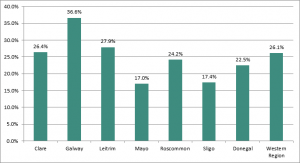The Western Development Commission (WDC) recently published its strategy for the next five years 2019-2024 ‘Work Smarter Live Better’. It was launched in Ballinasloe on 15th April, and that launch provided us with an opportunity to look back at how the seven county Western Region has changed since the WDC was set up.
The WDC was established by the Western Development Commission Act in 1998 so it is interesting to consider the changes experienced by the Region since the WDC came into being. As the seven counties (Donegal, Sligo, Leitrim, Mayo, Roscommon, Galway and Clare) which make up the Western Region (the area under the remit of the WDC) do not align with other statistical regions for data collection, the best Western Region data comes from sources which publish data by county, such as the Census of Population, which allow us to combine county data to get statistics for the Western Region. Comparing the Censuses of 1996 and 2016 gives a good picture of change in the Region over two decades. It is not often we look back so far but it is a useful exercise, highlighting how much has changed in twenty years.
In this post I briefly consider changes in population and demographics, labour force, employment, and finally, income. There are many other areas which merit examination which will be covered in a future post.
The Western Region population.
Looking first at population change, in 1996 the population of the Western Region was 657,231. By 2016 after a very significant 26.1% increase, it was 828,697. Different counties grew at very different rates, showing (Figure 1) the uneven rates of development and change.
The largest population growth in the period was in Galway, which grew by more than a third (36%) and the smallest population growth was in Mayo (17%) and Sligo (17.4%).
Figure 1: Population Change in Western Region counties 1996-2016
Source: CSO Statbank E2001: Population at Each Census 1841 to 2016 by County, Sex and Census Year
Demographic change
The make up of the population has also changed over that period. In 1996 13.7% of the Western Region population was over 65 and 3.3% was over 80. By 2016, 15.4% were over 65 and over 65 and 3.7% over 80.
More significant changes occurred in the younger age categories, in 1996 24% were under 15 while 41% were under 25 and by 2016 this had changed to 21.1% under 15 and 33% under 25.
Employment and the Labour Force
The labour force has grown even more significantly than the population. There were 266,102 in the labour force in the region in 1996 and this had grown to 387,770 by 2016, a 46% increase. The percentage of the population (aged 15-65) in the labour force was 53.5% in 1996 and had increased to 59.3% by 2016. This increase is largely the result of higher female participation and also reflects the changing age demographic.
Skills have also changed considerably. In 1996 in the Western Region only 16.7% had a third level qualification but by 2016 39.2% did.
My colleague Pauline White is currently undertaking a detailed analysis of employment by sector in the region and has published on six sectors. Looking at key Western Region sectors, the significant changes in employment are noted here.
In 1996 15.6% were employed in Agriculture, Forestry and Fishing and by 2016 only 6.8% were. Similarly, in 1996 19% of those in employment worked in Industry, and in 2016 13.7% did. In contrast, in 1996 40.1% were employed in Services but by 2016 67% were.
Incomes
Finally, although the data discussed so far is from the Census of Population it is useful to consider how income has changed over the same period. In 1996 Household Disposable Income per person was €15,032 in the Western Region (2016 prices) and by 2016 it had risen to €22,689 an increase of 51% over that period. However, in 1996 Western Region disposable income per person was 89.2% of the State average, but by 2016 it had fallen to 83.5% of the state average. Clearly the improvements in income have been greater in other parts of Ireland.
Conclusion
This short post has provided a useful reminder of how things have changed in the Western Region in the period since the WDC was set up. A future post will focus on spatial changes in infrastructure and where people live. Looking back, the changes that have taken place over the 20 year period examined have seemed dramatic, though many of them have taken place gradually. It is interesting to contemplate how things will change between 2016 and 2036 but, unless the retirement age increases even more, I won’t be around to blog about them. And perhaps blogging won’t be around either.
Helen McHenry










